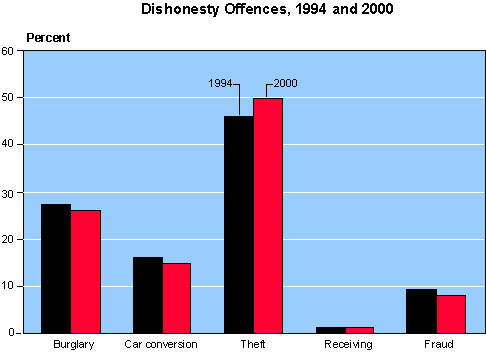| crime.files |
| |
 |
|

| crime.features |
| |
 |
|

| crime.resources |
| |
 |
|

| crime.co.nz |
| |
 |
|


|
 |  |

Dishonesty offences
The largest crime category (by a significant margin) is dishonesty offences, with 60 percent of all offences falling into this category in 2000
There are five classes of offence within this category, with theft constituting about 50 percent of all dishonesty offences, followed by burglary (26 percent), vehicle related offences (15), fraud (8) and receiving (1). The composition of the dishonesty offences category has shown little variation over the last seven years.
Figure 5:

Between 1994 and 1996, the total dishonesty offence rate rose slightly from 80 per 1,000 population to 83 per 1,000, before dropping to 66 per 1,000 in 2000. Figure 6 shows a small to moderate decrease in the offence rate since 1996 for nearly all types of dishonesty offences. The exception is receiving, which remained relatively unchanged over the period at approximately 1 per 1,000 population.
Figure 6:

One of the key result areas for police in the 1998/1999 year was targeting resources towards reducing the incidence and effects of house burglary and motor vehicle crime. Police continued to focus on these areas in the 1999/2000 year. Crime prevention methods used by the public, such as the use of burglar alarms and car alarms, may have had an effect on the offence rate for these offence classes.
Burglary is one of the high-profile offence classes, perhaps because many New Zealanders have had some contact with this class of crime -- either having had their homes burgled or knowing of someone who has had their home burgled. In the 1996 National Survey of Crime Victims, one-third of the respondents felt there was a crime problem in their neighbourhoods, with more than three-quarters of these identifying burglary as the major cause for concern.
Burglaries constituted 26 percent of all dishonesty offences and 16 percent of all offences in 2000. The resolution rate for burglaries was steady at about 12 percent between 1994 and 1999, but it rose to 16 percent in 2000.
Between 1994 and 2000, 98 percent of all burglaries were burglaries for property other than drugs. The offence rate for this type of burglary dropped to a low of 17 per 1,000 population in 2000, after sitting around 21 to 22 per 1,000 population from 1994 to 1997. There was about 1 burglary for drugs per 1,000 population in 2000, representing a 40 percent drop from 1994.
The other two types of burglary offences are aggravated burglaries and burglary associated offences, such as armed with intent to break and enter or disguised for burglary. There was no significant change in the offence rate for either of these types of burglary offences.
The highest resolution rate of all of the dishonesty offence classes was for receiving, ranging from 90 to 96 percent between 1994 and 2000. This rate is high because it is unusual for a receiving offence to be identified and recorded unless an offender is found in possession of stolen goods. The second highest resolution rate was for fraud (44 percent to 54 percent). All of the remaining dishonesty offence classes had resolution rates below 25 percent between 1994 and 2000.
|
 |
|

The largest crime category (by a significant margin) is dishonesty offences, with 60 percent of all offences falling into this category in 2000 |
|